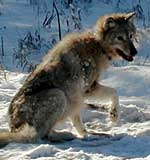By Tim Post
Minnesota Public Radio
January 31, 2002
|
| RealAudio |
Camp Ripley in Central Minnesota is one of the country's biggest National Guard training facilities. The 53,000-acre facility also serves as a huge wildife refuge. It's an island of wilderness that's home to animals that normally wouldn't be found in the area, like wolves. Researchers with the Department of Natural Resources are studying the lives of Camp Ripley's wolf packs and their prey.
| |
|
|
|
||
It's hard to forget Camp Ripley's military status. There are signs that point to firing ranges, and reminders not to pick up any ammunition you might find.
But this time of year, Camp Ripley feels like a big park. There's very little training going on. Just acres and acres of empty, quiet wooded hills. That's the kind of habitat that gray wolves love.
A pack of wolves moved to Camp Ripley from northeastern Minnesota seven years ago. Each year since then, researchers capture a number of wolves and deer to track the effect the species have on one another.
It's a major undertaking. A helicopter crew takes to the air to flush out a deer. The chopper whips up a flurry of snow - it adds a bite to the already bitter morning chill. The chopper cruises low and fast just over the tree tops.
Once a deer runs across an open field, there's a distant pop. Netting falls on the deer. The animal takes a tumble, but it's not hurt. The crew ties up the deer, and slings her under the chopper - back to waiting reseachers for a closer look.
The doe is given a couple of injections. Once she's unconcious, researchers huddle over her. They take her measurments, draw blood, check her for infections - they want to know her general health.
The image is of doctors working on a patient. In fact, researchers say their work is a lot like a doctor performing a physical.
Researchers know the deer is an important part of Camp Ripley's environment, because it's the primary prey for Camp Ripley's other resident, the wolf.
The next "patient" for researchers is a captured wolf, in this case, the pack's alpha female. She's already drugged when she arrives.
DNR researchers do the same tests they did on the deer, but they also attach a new radio collar to her neck. They can use the collar to track the wolf's movements in and around the camp.
| |
|
|
|
||
They want to know what habitat she likes, and where she and the pack flee when soldiers come to train. So far, researchers have found that even with its military activity, Camp Ripley is a great place for wolves.
"We get a lot of use in the summer months for military training, but most of the year we don't have anybody. There's very little activity out here, so it's really a fairly remote area," says Brian Dirks, who heads up the wolf study for the DNR.
Dirks says there are about eight wolves here at Camp Ripley. He says he's never had a complaint from area farmers about the packs. Dirks says there are so many deer here, wolves don't need to attack livestock, although they do wander away from the camp quite often.
Dirks says one male from the Camp Ripley pack spent seven months traveling to Green Bay, Wis., and back. He says that's how wolves search for a mate and look for their own territory.
But he says it's not likely any wolves will set up permanent packs south of Camp Ripley, in the state's more urban areas.
"You get into those areas and woods tend to be more fragmented and broken up, and it probably would affect their ability to go there," says Dirks. "But we don't know that yet. We are not sure what their limit is yet, how far they'll move in Minnesota. So that's one of the reasons we want to keep track of them and see what they are going to do, and see how far they are going to go."
The researchers only have about 10 minutes of study time before the wolf starts to shake off the drugs. She sits still for about a minute, then runs off into the woods. She'll likely be captured in coming years so she can be studied again.
The research on Camp Ripley's wolves will continue for several more years. It could take on new importance if the federal government decides to remove the wolf from the endangered species list.
If that happens, it would be up to the state to control the wolf population. The results of this study could help officials understand how to control the state's 2,500 wolves.


